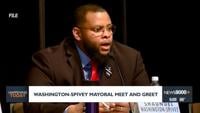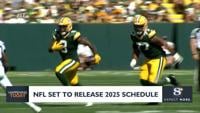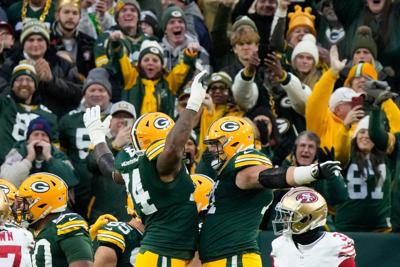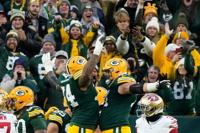GREEN BAY — General manager Brian Gutekunst and head coach Matt LaFleur never actually came out and said that they were unhappy with the Green Bay Packers’ offensive line.
But the team’s actions this offseason have sent a loud-and-clear message that that was the case in the wake of the team’s season-ending NFC playoff loss to the eventual Super Bowl LIX-champion Philadelphia Eagles.
So far, the Packers have:
• Signed ex-San Francisco 49ers lineman Aaron Banks to a four-year, $77 million free-agent deal to be their left guard;
• Made no effort whatsoever to re-sign center Josh Myers, who signed a one-year prove-it deal with the New York Jets after starting 53 games (including playoffs) over the past three seasons for Green Bay;
• Shifted Pro Bowl left guard Elgton Jenkins to center to replace Myers, with Gutekunst saying the club believes Jenkins could be an “All-Pro” at the position;
• Declared that the starting left tackle job is officially an open competition between incumbent Rasheed Walker, a 37-game starter (including playoffs) the last two years, and Jordan Morgan, the team’s first-round pick a year ago.
So would it really be all that surprising if. for next Thursday night’s first round of the 2025 NFL Draft, Gutekunst sends NFL commissioner Roger Goodell onto the stage of the theater outside Lambeau Field and up to the podium with an offensive lineman’s name on the card for the 23rd overall pick?
No. It wouldn’t be surprising at all.
For while the Packers do have more obvious, pressing needs — defensive line help, wide receiver help, cornerback help — it’s clear that the loss to the Eagles has seared a memory into LaFleur and Gutekunst’s brains: The image of an offensive line in shambles after Jenkins departed with a neck stinger after just four plays in what wound up being a 22-10 loss in Philadelphia.
Opting to play rookie sixth-round pick Travis Glover in Jenkins’ place — at least until the coaches benched Glover for another inexperienced and underqualified backup, ex-practice squadder Kadeem Telfort — and watching their offense self-destruct, clearly LaFleur and Gutekunst decided that day that they needed to bolster the line.
“We were pretty good last year … but I’m excited about the group that we have coming in,” LaFleur said. “Every season’s a new season, and you can’t take anything for granted.
“We’re excited about Banks coming in and then moving Elgton back to center. We feel like we have a lot of pieces. There’s going to be some good competition at a lot of spots. But you’ve got to re-create it each and every year, and the only way you do that is you get to work.”
Added Gutekunst: “I think we have the potential to be (much better). At the same time, those five guys have got to work in concert, and there’s a lot of work that has to be done before you ever get to that point. But I think we have the potential to be that.”
There’s also the reality that of the five projected opening-day starters, three of them — Walker at left tackle, Sean Rhyan at right guard and Zach Tom at right tackle — are entering the final year of their rookie contracts, meaning they’re all eligible for extensions now but they also could walk in unrestricted free agency next offseason.
Thus, the line is a sneaky need heading into the draft, and the Packers could take another lineman in the first round despite picking Morgan at No. 25 overall a year ago.
It wouldn’t be the first time, either: In 2010, the Packers took Iowa tackle Bryan Bulaga No. 23 overall, then took Mississippi State tackle Derek Sherrod at No. 32 overall the next year.
“We’ll always continue to address it because it’s such an important part of what we do,” Gutekunst said of the offensive line. “But I like the versatility of our guys. We work really hard on the guys that we bring into that building to have the versatility to do that, whether that’s because we have injuries or we have to shuffle the lineup to get the best five guys out there.”
Packers depth chart
63 Rasheed Walker LT 6-6 324 25 4 Penn State
65 Aaron Banks LG 6-5 325 27 5 Notre Dame
74 Elgton Jenkins C 6-5 311 29 7 Mississippi St.
75 Sean Rhyan RG 6-5 321 24 4 UCLA
50 Zach Tom RT 6-4 304 26 4 Wake Forest
77 Jordan Morgan T/G 6-5 311 24 2 Arizona
79 Travis Glover T 6-6 317 25 2 Georgia State
62 Jacob Monk C/G 6-3 308 23 2 Duke
67 Donovan Jennings G/T 6-4 323 26 1 South Florida
78 Marquis Hayes G 6-5 318 26 2 Oklahoma
Trey Hill C 6-4 319 25 4 Georgia
Best in class | Will Campbell, T, LSU.
There is a lot to like about the 6-foot-5, 319-pound Campbell, who started as a true freshman at left tackle in 2022 for the Tigers and went on to start all 38 games he played in Baton Rouge during his three college seasons.
He’s athletic, he’s agile, he’s got excellent feet, he’s fundamentally sound and he’s durable.
There’s also one thing not to like: His arm length, which NFL personnel types tend do obsess over.
Having measured at 32 5/8-inches, Campbell’s arms are shorter than the industry norm. Of course, so were ex-University of Wisconsin star Joe Thomas’ arms, but he managed to overcome that — pardon the pun — shortcoming to play 11 NFL seasons with the Cleveland Browns and land in the Pro Football Hall of Fame, despite his 33 3/4-inch arms.
“For two years, nobody had any measurements on me and nobody said anything about my play,” Campbell said following his on-campus pro day last month, when his arms measured at 33 inches. “So now, all of a sudden, an arm length decides if I’m a good player or not? I think it’s BS.”
Best of the rest | Armand Membou, T, Missouri; Josh Simmons, T, Ohio State; Tyler Booker, G, Alabama; Kelvin Banks Jr., G, Texas; Grey Zabel, C, North Dakota State.
Pick to click | Jack Nelson, T, Wisconsin.
A Badger through and through, Nelson bounced back from a disappointing 2023 season by returning to UW for one more year to not only improve his draft stock but to help steady the line. He did both.
“I don't think I performed my best that (2023) season, and I knew I had a lot more to prove,” Nelson confessed at the annual NFL scouting combine in Indianapolis in February. “I felt like I owed it to Wisconsin — a city, a program that had given me so much, the university itself given my family so much. And I decided I owed it to them to really give everything I had to that program.”
As most Badgers fans know, Nelson grew up in Stoughton and was the Vikings’ starting left tackle as a sophomore, junior and senior before attending UW—where his father, Todd, was a three-year starter on the offensive line and was a captain as a senior in 1988. Todd was also a teammate and roommate of former Badgers head coach Paul Chryst, who recruited the younger Nelson to UW.
The then-Phoenix Cardinals took Todd in in the 12th round (No. 318 overall) of the 1989 NFL Draft, but the 6-foot-7, 318-pound Jack figures to go on Day 3 of this year’s draft, likely in the fifth or sixth round.
“Going from being an old, experienced starter at Wisconsin to a new rookie, it's all about keeping your head down and working — letting your work do the talking,” Nelson said of adjusting to the pro game. “I think it's just all about coming in there, putting your head down, working, and proving that you're there to belong."
History lesson | One could have argued that Gutekunst largely ignored the importance of replenishing the offensive line during his first two drafts. But he’s been a different drafter ever since.
In 2018, the only lineman he selected was Washington State’s Cole Madison in the fifth round. Madison missed his rookie season while working to improve his mental health and then suffered a torn ACL that wiped out what would have been his debut season in 2019.
And Jenkins, a two-time Pro Bowl selection who is among Gutekunst’s best draft picks, was the only lineman he took in 2019. Jenkins was a second-round draft choice, selected two picks after Missouri quarterback Drew Lock, whom Gutekunst coveted, went to the Denver Broncos.
But since then, Gutekunst has loaded up on linemen, espousing his predecessor and mentor Ted Thompson’s credo that, “The good Lord only made so many big guys.”
Thompson always saw the offensive line as a vital building block of a roster, and Gutekunst’s recent drafts reflect Thompson’s influence more than anything.
In his 13 drafts, Thompson added at least two offensive linemen eight times. And only once, in 2015, did he complete a draft without having taken a single lineman.
Of his first-round picks as GM, Thompson used most of them on defense (9 of 12) but did pick offensive linemen in 2010 (Bryan Bulaga) and 2011 (Derek Sherrod). He also invested two second-rounders and one third-rounder on the line, but had most of his success with his fourth- and fifth-round picks.
Now, look at what Gutekunst has done in the last few years, taking three linemen in in four of the last five drafts.
He took three in 2020 (although all three are gone), three more in 2021 (all three of them are gone, too, following Myers’ free-agent departure) and three again in 2022 (Rhyan, Tom and Walker, all of whom are penciled in as starters at the moment).
Although he didn’t pick a lineman in 2023, he took three more in last year’s draft (Morgan, Monk and Glover). If Gutekunst can add a couple more selections to the eight he currently holds, don’t be surprised if he takes a couple more linemen this year.
Next: Defensive linemen.
COPYRIGHT 2025 BY CHANNEL 3000. ALL RIGHTS RESERVED. THIS MATERIAL MAY NOT BE PUBLISHED, BROADCAST, REWRITTEN OR REDISTRIBUTED.




